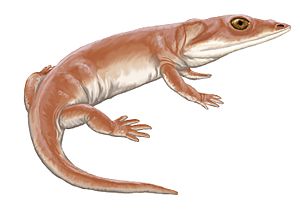Lapillopsis facts for kids
Quick facts for kids LapillopsisTemporal range: Early Triassic
|
|
|---|---|
 |
|
| Restoration of Lapillopsis nana | |
| Scientific classification |
|
| Kingdom: | Animalia |
| Phylum: | Chordata |
| Order: | †Temnospondyli |
| Suborder: | †Stereospondyli |
| Family: | †Lapillopsidae |
| Genus: | †Lapillopsis Warren and Hutchinson, 1990 |
| Type species | |
| †Lapillopsis nana Warren and Hutchinson, 1990
|
|
Lapillopsis was an ancient type of amphibian that is now extinct. It belonged to a group called stereospondyl temnospondyls. These were early amphibians. Scientists have found its fossils in Queensland, Australia. These fossils were discovered in a rock layer known as the Arcadia Formation.
Discovery of Lapillopsis
The only known species of Lapillopsis is Lapillopsis nana. It was named in 1990 by Australian scientists Anne Warren and Mark Hutchinson. The name Lapillopsis comes from Latin words. Lapillus means "pebble" and -opsis means "appearance." This name was chosen because the fossils were found inside small, pebble-like rocks.
Scientists have found two main specimens of Lapillopsis nana. Both are nearly complete skulls with lower jaws. They also include some other bones from the body. In 1999, another 14 specimens were described. These were found in the same area.
What Lapillopsis Looked Like
Lapillopsis had some special features that helped scientists tell it apart. It was different from a similar animal called Rotaurisaurus. Here are some of its unique traits:
- It had a deep, curved notch near its ear area.
- The back part of its skull was short.
- A wide, shallow groove ran across its cheekbone.
- The front part of a bone in its mouth (the cultriform process) was wide.
- Some bones in its mouth (pterygoid and palatine) were separate. This created a gap.
- A bone in its cheek (the jugal) ended at the front of its eye socket.
Scientists know a lot about its skull and lower jaw. This has allowed them to create a good picture of what its head looked like. They also have some bones from its shoulders, front limbs, and a few backbones.
Lapillopsis in the Family Tree
When Lapillopsis was first named, scientists thought it was related to a group called Dissorophoidea. Most animals in this group lived in the Paleozoic Era. However, Lapillopsis lived later, in the Early Triassic period.
In 1999, more fossils of Lapillopsis were found. A new animal called Rotaurisaurus was also discovered. This led a scientist named Adam Yates to create a new family group. He called it Lapillopsidae. This group included Lapillopsis and Rotaurisaurus. These were unusual, small-bodied amphibians.
Later studies have placed Lapillopsis in different spots on the amphibian family tree. Some studies suggest it is a very early member of the Stereospondyli group. Other research has linked it more closely to a group called Lydekkerinidae. This group also includes small amphibians from the Early Triassic.
So, while scientists agree that Lapillopsis is an early amphibian, its exact place in the family tree is still being debated. This is common in paleontology, as new fossils and research can change our understanding.

